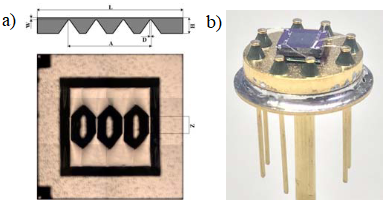Xiangguang Han, Mimi Huang, Zutang Wu, Yi Gao, Yong Xia, Ping Yang, Shu Fan, Xuhao Lu, Xiaokai Yang, Lin Liang, Wenbi Su, Lu Wang, Zeyu Cui, Yihe Zhao, Zhikang Li, Libo Zhao
and Zhuangde Jiang
Advances in high-performance MEMS pressure sensors: design, fabrication, and packaging.
Microsyst Nanoeng 9, 156 (2023)
DOI:10.1038/s41378-023-00620-1
1 State Key Laboratory for Manufacturing Systems Engineering, Xi’an Jiaotong University, Xi’an 710049, China
2 International Joint Laboratory for Micro/Nano Manufacturing and Measurement Technologies, Xi’an Jiaotong University, Xi’an 710049, China.
3 School of Mechanical Engineering, Xi’an Jiaotong University, Xi’an 710049, China.
4 Northwest Institute of Nuclear Technology, Xi’an 710024, China
Abstract: Pressure sensors play a vital role in aerospace, automotive, medical, and consumer electronics. Although microelectromechanical system (MEMS)-based pressure sensors have been widely used for decades, new trends in pressure sensors, including higher sensitivity, higher accuracy, better multifunctionality, smaller chip size, and smaller package size, have recently emerged. The demand for performance upgradation has led to breakthroughs in sensor materials, design, fabrication, and packaging methods, which have emerged frequently in recent decades. This paper reviews common new trends in MEMS pressure sensors, including minute differential pressure sensors (MDPSs), resonant pressure sensors (RPSs), integrated pressure sensors, miniaturized pressure chips, and leadless pressure sensors. To realize an extremely sensitive MDPS with broad application potential, including in medical ventilators and fire residual pressure monitors, the “beam-membrane-island” sensor design exhibits the best performance of 66 μV/V/kPa with a natural frequency of 11.3 kHz. In high-accuracy applications, silicon and quartz RPS are analyzed, and both materials show ±0.01%FS accuracy with respect to varying temperature coefficient of frequency (TCF) control methods. To improve MEMS sensor integration, different integrated “pressure + x” sensor designs and fabrication methods are compared. In this realm, the intercoupling effect still requires further investigation. Typical fabrication methods for microsized pressure sensor chips are also reviewed. To date, the chip thickness size can be controlled to be <0.1 mm, which is advantageous for implant sensors. Furthermore, a leadless pressure sensor was analyzed, offering an extremely small package size and harsh environmental compatibility. This review is structured as follows. The background of pressure sensors is first presented. Then, an in-depth introduction to MEMS pressure sensors based on different application scenarios is provided. Additionally, their respective characteristics and significant advancements are analyzed and summarized. Finally, development trends of MEMS pressure sensors in different fields are analyzed.
Fig: High-sensitivity MDPS, on-chip amplified MDPS, and resonant MDPS.
Acknowledgements: This study was supported in part by the National Key Research and Development Program of China (2021YFB3203200) and the Natural Scienc Foundation of Shaanxi (2022JQ-554).


